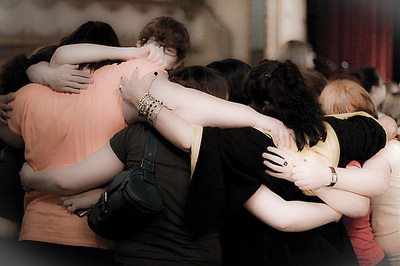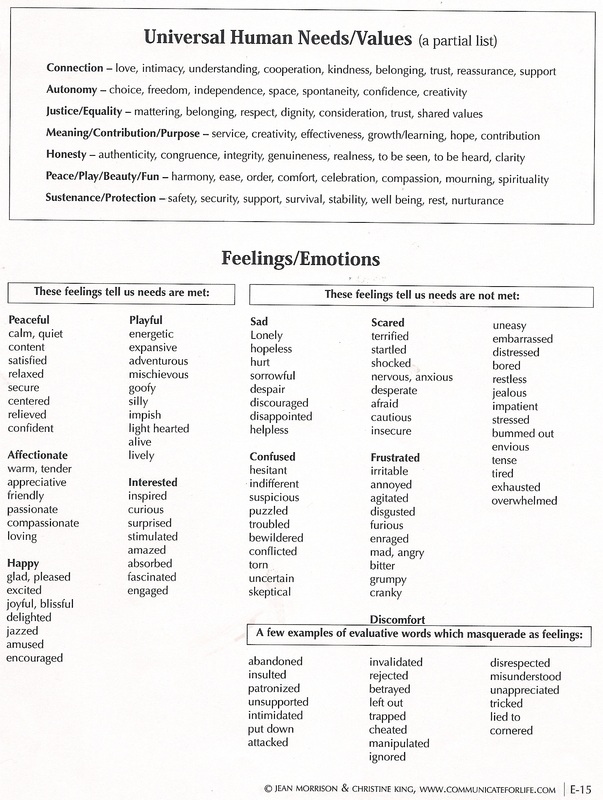COMPASSIONATE LANGUAGE-A PRACTICE TO BRING PEACE TO YOURSELF, AND TO SPEAK AND LISTEN IN WAYS THAT LEAD TO CONNECTION AND UNDERSTANDING.
|
When we're wanting to change how we communicate and we're learning Nonviolent Communication we often focus on trying to apply the language and the consciousness of compassion during the most difficult situations - conflict with our loved ones. One of the most helpful things I was told while trying to integrate nonviolence into my life was how important Empathy for Joy was. What does this mean?
Empathy for Joy is noticing when Needs are met - when we're connected to what we value. Notice when you have connection, when you feel reassured, when you feel included and have a sense of belonging. Notice when you feel love, peacefulness, calm, excitement and ask yourself "What Needs of mine am I connected to?" or "What Needs are met right now?" Name them - "Ahhh, Connection, Belonging, Hope, Reassurance, Fun & Play." Recently, a Meditation group I'm part of that meets monthly began studying Rick Hanson's book Hardwiring Happiness (which I highly recommend). AND you can watch him on You tube for some quickie ways to actually balance out what he calls our brain's Negativity Bias. In short, this isn't about making more happy things happen by getting that special job, or having everyone in your life be perfectly ok in any moment, or about having a certain someone, or car or vacation. It's about NOTICING when Needs are met and letting it sink in. His process is called HEAL. Have a "good" experience - meaning notice when your Needs are met. Enhance it - Take a few moments to name the Need met, and feel it in your body, notice what it's like to have this need met. Pause, take it in. Absorb it - Even saying the Need and relishing how important this need is, visualize it filling your body up. You can do this for 30 seconds and it has an effect. Link - This part is optional. Link the good experience (Needs met) to a time when you didn't have Needs met. He says to have caution for this part to have support if it's a big trauma or trigger. Start small, if you're feeling inclusion link this to a memory you have of being at a party and for a moment having no one to talk and feeling a bit awkward, longing for acceptance. For years I've had a practice as I get ready for bed and settle in for the night, I name 3 Needs of mine that were met that day. I often drift off to sleep while naming many, many Needs met. And now I've learned that this and other Empathy for Joy practices are actually hardwiring my brain for Happiness. Balancing out my brain (and everyone else's) bias for what is wrong. We now have the science behind the importance of Empathy for Joy and the power of Empathy. It may even make it more possible to have empathy when Needs aren't met because as Rick Hanson says, we fill our bucket up drop by drop. So put a drop in the bucket today! And give empathy for Joy to others! When they are excited, happy, joyful, or peaceful guess what Needs of theirs are met - "Wow, you look really excited about the meeting. Do you have a sense of contributing and being seen for your expertise?" or "Sounds like you're really grateful that you have a such friendship in your life?" For this week - try 3 times a day, pausing and noticing Needs met and then trying the HEAL process for 30 seconds, notice how you feel. Or just notice the Needs that are met and notice how you feel in your body and what the state of your heart is. Notice when others have their Needs met. Let me know how your week goes! Please put comments on facebook! (It inspires others). IF YOU WANT TO KNOW MORE ABOUT WHAT Universal Needs are - click the link above that says More and choose Resources. At the bottom of the page is a list of Universal Needs that Marshall Rosenberg created as a core part of Nonviolent Communication. Universal Needs means that it is a value that everyone wants to be able to thrive. Everything we say and do is to meet or connect with a value or Universal Need, therefore having awareness of Needs, or a Needs consciousness, increases our ability to be aware and clear about what it is we value that is up for us in any moment. When we clarify what is important to us, we move toward it - it is on our radar. And when we notice when Needs are met we are more likely to continue to do the thing that contributed to our Needs being met. It helps us have compassion and self-responsibility for ourselves. Needs awareness also helps us have compassion for others - we are able to see them as human again. We need more of this in our lives. IF YOU WANT TO LEARN MORE ABOUT THIS POWERFUL STUFF look at the classes I have coming up and come! Or look at the books I list under Resources and start reading today!
0 Comments
 I always seem to get an epiphany while I’m running. Things that relate to life. It’s a place for me to practice "being with" and noticing what happens when I don’t resist. Often while I’m running I begin to feel fatigued or something hurts and I want to stop. I begin to resist and I tense up, which takes me out of a better form for running. So, I decided one day to look at what I was telling myself. I realized there was an unconscious part that was saying, “You’re getting too tired! You can't do this. It's not ok! You need to stop!” It's the part of my brain that monitors my physical state and wants to keep me alive. Once I was aware of the thoughts then I could gain perspective, and check if they were true. Funny how in life there are thoughts in the subconscious, but just by bringing them to light, they lose their power. Different than just “thinking positively”. To me it’s about increasing my tolerance just to be with however I’m feeling. First I need to notice the underlying thoughts. Because it’s my thoughts that bring about my feelings. I learned this when I learned W.A.I.T: What Am I Telling Myself? And then I look at what I’m feeling when I’m telling myself those thoughts. So after the thoughts I noticed my feelings. I felt worried and stressed, because I wanted reassurance and trust in my body. And I wanted well-being and definitely comfort. So instead of running and thinking, “When can I stop?! ” or “I can’t do this. I can’t handle it”, I decided to experiment and just be with the feelings of worry and stress and relax into "this is where I am. I have some resistance." And suddenly relief came, much more than when I resisted the thoughts or tried to talk myself out of them. The more I just said “Yup, I’m tired and worried because I'm wanting to trust I can do this and I want ease from discomfort.” - the more I felt at ease running and enjoyed the journey. As soon as I accepted and stopped resisting, I began to be less tight and my true, natural form of running returned. I began to look at the trees instead of my watch, and worried less about when I could stop. I experimented with just saying what I valued - trust, well being, reassurance and that I could keep going. Then I began to appreciate the parts of my body that felt strong. And I thought how important this is for me to do in life. Be with what is and keep going and get to gratitude. Not resisting when pain or worry comes up, not beating myself up for having my feelings, but mindfully choosing to be with it and, most importantly, getting to what it is that I value – Reassurance, Trust, Care for others, Peace of mind, etc. Then I begin to move towards what I’m wanting. When I resisted it was like those feelings went downstairs and lifted weights and came back when I didn’t expect it! “What we resist, persists.” In allowing I found more gratitude in the process, too. I never thought I would learn to be OK with any feeling and be able to handle life. Such a tool for empowerment! So the next time one of my kids did something that triggered me where I found myself furrowing my brow and sighing, I stopped and did WAIT. I was telling myself that they weren’t functioning and so never would. That I was messing up for not teaching them better. That they weren't safe. "Really? Is that true?" Just noticing this gave me a bit of distance from having thoughts and having them be my reality and the truth. I realized I felt anxious, scared, and discouraged. I remembered Tara Brach’s Yes Meditation. And so, although I felt a bit silly, I said out loud to myself, “Yes to worry." Breath. "Yes to fear." Another breath. "Yes to discouragement.” And I realized I wanted reassurance for them being ok, to have Peace of mind and to Trust. When I became aware of these values then requests came as to how I could trust and find reassurance. That gave me compassion so I could be aware and act out of choice rather than react out of fear. Whew. That felt reassuring. I could decide to trust. I felt so much more resilient. Maybe THIS was all I needed to teach my children. Help them know how to be with any feeling that comes up. And to show them how to look at what's important to them that's connected to that feeling, what they value. Then I’d be reassured that THEY can increase their window of tolerance and be resilient, too. Rather than resisting life, they, like me could run towards life. Summary: 1. Breathe 2. W.A.I.T. What Am I Thinking? What am I resisting? 3. What is my body telling me - What am I feeling? What do I feel in my body? 4. Connect to my core, literally and figuratively. What do those emotions point to? What is important to me? What are my Universal Needs? 5. Breathe into what's important to me. Picture breathing that need into my heart. Savor it. Rest in Gratitude for those precious values. 6. See if any requests come. COMMENTS: CLICK HERE to share a comment on my facebook page.
And repeat three times "It's not, it's not, it's not about me, When you understand, you cannot help but love.  Since it's near Valentines Day it seems appropriate to write about Love. Why is it that it is often the hardest to communicate with the ones we love? Why is it that we misunderstand the slightest of things, and react? Or that we also say things that don't show the care we really feel? Is it that we want to protect ourselves from pain? And it seems like such a paradox that we want to protect the ones we love from any pain and doing this we say things that often bring hurt and disconnection. For example, if someone I love is in pain, my brain kicks in that I must rescue them from this pain. So if they are feeling discouraged and don't have trust that they can do something, I say "Yes, you can! You're amazing!" in hopes of reassurance. Yet all they hear is that they shouldn't feel bad. Then they're all alone in their feelings because I don't get it. And they're even worse because they don't just "get over it and move on." which would make me happy. ARGGG! And they react with "You don't understand" or "Yes, BUT blah, blah blah" or whatever to justify their feelings and we go back and forth. And pretty soon, they walk away. I'm acting out of love, but my care is not being received. How do I show my love? Am I the only one that goes through this? What's so ironic is that when I'm hurting, and I feel sad or disallusioned or hopeless, I just want someone to get how much pain I'm in, not to solve it, just to be with me and understand. So I know how it feels, yet I still jump in. I realize not everyone feels this way, many people report they just want relief from the pain. I've never seen being talked out of it really working though in either case. It's like the pain never really gets heard and so goes back into hiding, waiting to come out. And we feel alone in it. What I have learned, through lots of "mistakes" and opportunities to learn, is that Empathy first really helps with connection and understanding. It's really unconditional love - showing that I can receive and be with whatever feeling or thought my loved one has, with no judgment that they need to shift or change or be different right now. Showing them they are not alone in their pain! Then there is no condition on my love - they don't have to be happy, or be "over it" to be loved. I love them with all their thoughts and feelings! Mostly that I get how they are right now and that they are not their feelings or their thoughts. They are having an experience that I can acknowledge and walk along side them in. And in so doing, I may ease their suffering. My children have been my teachers in this. Especially my oldest daughter, who now can articulate - "I just want you to get how hard this is for me right now and how much I hurt." Wow, that helps me. She has been my greatest teacher of learning to understand and learning to be in empathy with her, instead of consoling or fixing her. There is nothing wrong, nothing is broken. So I can meet my need for showing love by hearing and either offering silent empathy or empathy out loud. It might sounds like: "Wow, I hear you're really hurting right now. You're really doing the best you can right now and it's hard. And you feel really sad because you aren't connected to trust in yourself or in your competence? Did I get the place you're in?" So for Valentines Day or any time when we want to show love, show your unconditional love by listening, and really getting where your loved one is coming from - give the gift of empathy. It's a gift for you because you'll have your needs for contribution to your loved one met! And it's a gift for them to have some understanding and companionship when they're hurting. They'll let you know if they were heard. And then you can check in with them and see if they'd like your offer of reassurance or hope, if that's what they're wanting. When you understand, you love!
|
AuthorMarcia has been studying and practicing Nonviolent Communication since 2005. She has experienced immense joy & gratitude while learning this consciousness. This blog reflects some of that learning. Archives
April 2020
Categories
|





 RSS Feed
RSS Feed

